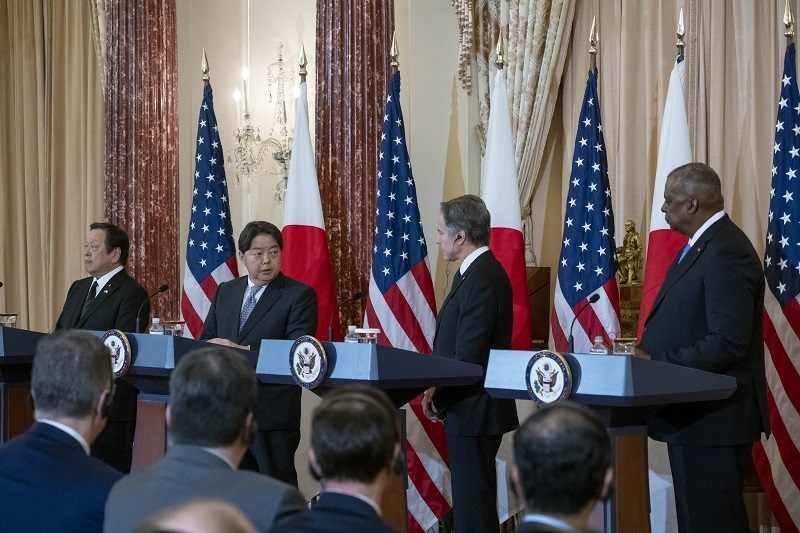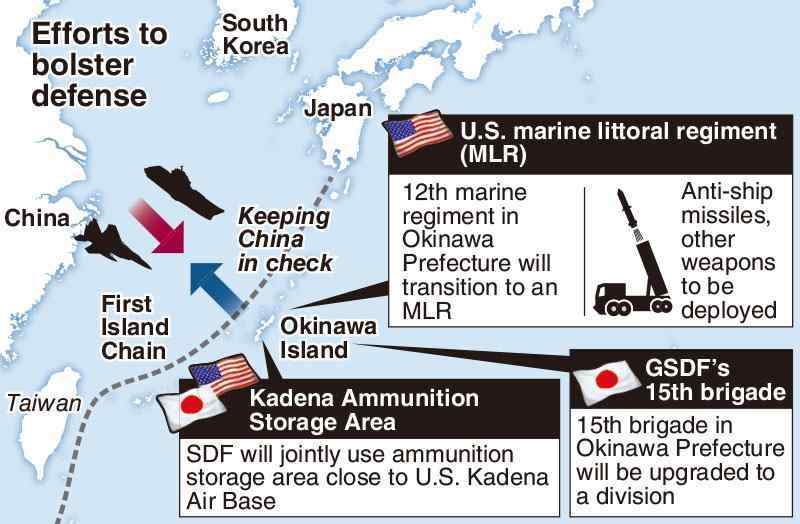
From left: Defense Minister Yasukazu Hamada, Foreign Minister Yoshimasa Hayashi, U.S. Secretary of State Antony Blinken and U.S. Secretary of Defense Lloyd Austin speak during a news conference at the State Department in Washington on Wednesday.
7:00 JST, January 14, 2023
WASHINGTON — A clear takeaway from the latest 2-plus-2 talks of the Japanese and U.S. foreign and defense ministers was the shift toward reinforcing the defense of the Nansei Islands.
At the meeting in Washington on Wednesday, the United States announced the establishment of a U.S. marine littoral regiment (MLR) in Okinawa Prefecture that can respond promptly to an emergency on Japan’s remote islands. This reflects the increasingly realistic concerns that an emergency affecting Taiwan could occur.
The Japan-U.S. pivot toward the Nansei Islands, which span Kagoshima and Okinawa prefectures, and the bolstering of the Self-Defense Forces are aimed at enhancing deterrence against China. Tokyo and Washington intend to deepen their cooperation and push ahead with discussions regarding Japan’s intended acquisition of counterstrike capabilities.
In the 2-plus-2 talks, Defense Minister Yasukazu Hamada emphasized the need for Japan and the United States to strengthen their ability to respond quickly, especially in the event of an emergency affecting Taiwan.
“This effort will significantly strengthen the deterrence and response capabilities of the Japan-U.S. alliance,” Hamada said at a joint press conference. “We agreed on the need to realize a division of roles and missions assuming the fundamental reinforcement of Japan’s defense capabilities.”
The transition of a U.S. Marine Corps regiment stationed in Okinawa Prefecture into a marine littoral regiment by 2025 is a central pillar of this plan. The MLR will consist of about 1,800 to 2,000 personnel and include missile units that can attack enemy ships at long range and an air defense battalion equipped with anti-aircraft missiles. The regiment will be able to split into small groups that can be deployed to individual remote islands to fend off attacks within range of enemy fire, deter the movements of enemy ships and aircraft, and secure control of nearby waters.
The Marine Corps has in recent years been morphing into a more agile force by, among other steps, reducing the size of its tank fleet, artillery arsenal and other equipment. The MLR would epitomize this change. The plan is to have three such regiments in the Pacific region. The first MLR was launched in Hawaii in March 2022, and Okinawa has now been decided as the location for the second. The U.S. territory of Guam is a leading candidate to host the third MLR.
In the event of an incident involving Taiwan, China is expected to implement a military strategy known as “anti-access/area denial.” The strategy aims to block U.S. military operations inside China’s side of the western Pacific’s Second Island Chain — which runs from the Izu islands down to Guam — and prevent U.S. forces from penetrating the First Island Chain that links the Nansei Islands and the Philippines.
China has been improving its missile capabilities, so U.S. warships might struggle to safely approach the region. Having an MLR in Okinawa — which is within range of China — in peacetime would be a decisive factor in efforts to deter Beijing.
In the 2-plus-2 talks, the U.S. side mentioned a plan to set up a small landing craft unit at the U.S. military’s Yokohama North Dock facility in Kanagawa Prefecture in around spring this year. The unit, which will consist of 13 ships and about 280 personnel, has the advantage of being able to carry large volumes of supplies and dock at shorelines that do not have port facilities.
Kiyofumi Iwata, a former chief of staff of the Ground Self-Defense Force, applauded the changes. “Working in concert with the SDF’s strategy for defending the Nansei Islands will strengthen the deterrence capabilities of Japan and the United States,” Iwata said.
Concentration of forces
The new Defense Buildup Program outlined a plan to upgrade the GSDF’s 15th brigade, which is stationed in Naha and has about 2,200 personnel, into a division, which has about 3,000 personnel. The program also stated that eight divisions, five brigades and others stationed across the nation will essentially become more mobile with a possibility of deployments on the Nansei Islands in mind.
Boosting the nation’s ability to transport equipment and deliver supplies will be key during combat operations on remote islands. Consequently, a transport ship unit will be formed and the number of transport ships and aircraft significantly increased. The government also plans to press ahead with the construction of ammunition storage facilities and supply bases in the Nansei region.
The U.S. military has been urging Japan behind the scenes to strengthen its supply capabilities to support the SDF’s ability to continually engage with an enemy. In the 2-plus-2 talks, both sides confirmed the joint use of facilities at the U.S. military’s Kadena Ammunition Storage Area in the village of Yomitan and elsewhere in Okinawa Prefecture.

Growing sense of urgency
A shared sense of urgency and concern about the possibility of an emergency involving Taiwan spurred the shift by Tokyo and Washington toward greater emphasis on the Nansei Islands.
“Regarding an emergency involving Taiwan, it is not a question of if, but when,” a senior SDF official said to The Yomiuri Shimbun. “Efforts to concentrate resources in the Nansei Islands are continually being considered.”
However, the construction of ammunition storage and other facilities will also require coordination with local authorities. “There is the relationship with the local communities, and we will have to continue our effort to explain in order to overcome these challenges,” Hamada said at the joint press conference.
Counterstrike capabilities
Japan’s decision to acquire counterstrike capabilities was a major item on the 2-plus-2 agenda.
The possession of such capabilities and close coordination with the United States will strengthen the deterrence provided by the Japan-U.S. alliance.
An improved version of the GSDF’s Type 12 surface-to-ship guided missile will likely be one of the main components of such capabilities.
Deployment of the modified missiles will start in fiscal 2026 at the earliest. The Defense Ministry plans to buy U.S. Tomahawk cruise missiles for use in counterstrike scenarios in case there is a delay in the missile upgrade.
Washington’s support will be essential for this. So far, the United States has sold Tomahawks to only Britain. During the latest 2-plus-2 talks, the United States promised to fully support Japan’s acquisition of counterstrike capabilities.
“The strong support shown by Secretary [of Defense Lloyd ]Austin and Secretary [of State Antony] Blinken is extremely encouraging,” Hamada said at the joint press conference.
The foreign and defense chiefs also agreed to deepen bilateral cooperation on pinpointing potential targets, which would be an essential element of a counterstrike.
Japan plans to launch a network of small satellites operating in unison to collect real-time information. This satellite “constellation” would also strengthen the nation’s targeting capabilities. However, Japan must rely on information provided by U.S. satellites for the time being.
The ministers also agreed that “attacks to, from or within space” could lead to the invocation of Article 5 of the Japan-U.S. Security Treaty, which stipulates the United States’ obligation to defend Japan.
According to Jeffrey Hornung, a senior political scientist at the RAND Corporation think tank in the United States, applying Article 5 of the treaty to space was logical given the need for greater integration between Japan and the United States on satellites.
Japan will also deepen cooperation with the United States to build an integrated air and missile defense system.
A revision of the Japan-U.S. defense cooperation guidelines, which spell out the roles of the SDF and the U.S. military in peacetime and during an armed attack, will likely be considered once details regarding Japan’s acquisition of counterstrike capabilities are confirmed.
“We don’t assume that it will be immediately necessary” to review the guidelines, Foreign Minister Yoshimasa Hayashi said at the joint press conference. However, a senior Japanese government official said, “We first want to hold a round of talks regarding how the guidelines would be applied, with a view to revising them at some point in the future.”
"Politics" POPULAR ARTICLE
-

Japan to Support Central Asian Logistics Route That Bypasses Russia, Plan to Be Part of Upcoming Summit in Tokyo
-

Japan to Tighten Screening of Foreigners’ Residential Status by Providing Information of Nonpayment of Taxes
-

Chinese, Russian Bombers Flew Unusual Path by Heading Toward Tokyo; Move Likely Meant to Intimidate Japan
-

Japan Plans National Database to Track Foreign Ownership of Real Estate, Land as It Weighs New Rules
-

Up to 199,000 Deaths Estimated From Mega-Tsunami; Most Recent Occurrence Took Place in 17th Century
JN ACCESS RANKING
-

Tokyo Economic Security Forum to Hold Inaugural Meeting Amid Tense Global Environment
-

Keidanren Chairman Yoshinobu Tsutsui Visits Kashiwazaki-Kariwa Nuclear Power Plant; Inspects New Emergency Safety System
-

Imports of Rare Earths from China Facing Delays, May Be Caused by Deterioration of Japan-China Relations
-

University of Tokyo Professor Discusses Japanese Economic Security in Interview Ahead of Forum
-

Japan Pulls out of Vietnam Nuclear Project, Complicating Hanoi’s Power Plans






















